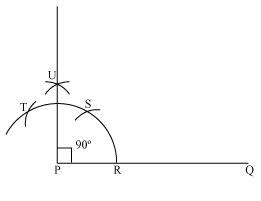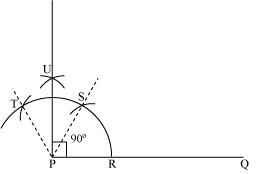Find the best tutors and institutes for Class 9 Tuition
Search in
Construct an angle of 90 0 at the initial point of a given ray and justify the construction.
The steps required to construct an angle of 90° is as follows.
(i)Consider the given ray PQ. Draw an arc of some radius making point P as its centre, which intersects PQ at R.
(ii) Now, taking R as centre with the same radius as before, draw an arc intersecting the previously drawn arc at S.
(iii) Mark S as centre with the same radius as before, draw an arc intersecting the arc at T (see figure).
(iv) Taking S and T as centre, draw an arc of same radius to intersect each other at U.
(v) Join PU, which is the required ray making 90° with the given ray PQ.

Justification of Construction:
We can justify the construction, if we can prove ∠UPQ = 90°.
For this, join PS and PT.

We have, ∠SPQ = ∠TPS = 60°. In (iii) and (iv) steps of this construction, PU was drawn as the bisector of ∠TPS.
∴ ∠UPS = ![]() ∠TPS
∠TPS![]()
Also, ∠UPQ = ∠SPQ + ∠UPS
= 60° + 30°
= 90°
Construct an angle of 45° at the initial point of a given ray and justify the construction.

 UPQ = 90o.
UPQ = 90o.
 SPQ =
SPQ =  TPS = 60o. In (iii) and (iv) steps of this construction, we have drawn PU as the bisector of
TPS = 60o. In (iii) and (iv) steps of this construction, we have drawn PU as the bisector of  TPS.
TPS.
Construct the angles of the following measurements:
(i)
(ii)
(iii)
(i)30°
Step I: Draw the given ray PQ. Taking P as centre and with some radius, draw an arc of a circle which intersects PQ at R.
Step II: Taking R as centre and with the same radius as before, draw an arc intersecting the previously drawn arc at point S.
Step III: Taking R and S as centre and with radius more than ![]() RS, draw arcs to intersect each other at T. Join PT which is the required ray making 30° with the given ray PQ.
RS, draw arcs to intersect each other at T. Join PT which is the required ray making 30° with the given ray PQ.

(ii)![]()
(1) Take the given ray PQ. Draw an arc of some radius, taking point P as its centre, which intersects PQ at R.
(2) Taking R as centre and with the same radius as before, draw an arc intersecting the previously drawn arc at S.
(3) Taking S as centre and with the same radius as before, draw an arc intersecting the arc at T (see figure).
(4) Taking S and T as centre, draw an arc of same radius to intersect each other at U.
(5) Join PU. Let it intersect the arc at point V.
(6) From R and V, draw arcs with radius more than ![]() RV to intersect each other at W. Join PW.
RV to intersect each other at W. Join PW.
(7) Let it intersect the arc at X. Taking X and R as centre and radius more than ![]() RX, draw arcs to intersect each other at Y.
RX, draw arcs to intersect each other at Y.
Joint PY which is the required ray making ![]() with the given ray PQ.
with the given ray PQ.

(iii) 15°
Step I: Draw the given ray PQ. Taking P as centre and with some radius, draw an arc of a circle which intersects PQ at R.
Step II: Taking R as centre and with the same radius as before, draw an arc intersecting the previously drawn arc at point S.
Step III: Taking R and S as centre and with radius more than ![]() RS, draw arcs to intersect each other at T. Join PT.
RS, draw arcs to intersect each other at T. Join PT.
Step IV: Let it intersect the arc at U. Taking U and R as centre and with radius more than ![]() RU, draw an arc to intersect each other at V. Join PV which is the required ray making 15° with the given ray PQ.
RU, draw an arc to intersect each other at V. Join PV which is the required ray making 15° with the given ray PQ.

Construct the following angles and verify by measuring them by a protractor:
(i)
(ii)
(iii)
(i) 75°
(1) Take the given ray PQ. Draw an arc of some radius taking point P as its centre, which intersects PQ at R.
(2) Taking R as centre and with the same radius as before, draw an arc intersecting the previously drawn arc at S.
(3) Taking S as centre and with the same radius as before, draw an arc intersecting the arc at T (see figure).
(4) Taking S and T as centre, draw an arc of same radius to intersect each other at U.
(5) Join PU. Let it intersect the arc at V. Taking S and V as centre, draw arcs with radius more than ![]() SV. Let those intersect each other at W. Join PW which is the required ray making 75° with the given ray PQ.
SV. Let those intersect each other at W. Join PW which is the required ray making 75° with the given ray PQ.

(ii) 105°
The below given steps will be followed to construct an angle of 105°.
(1) Take the given ray PQ. Draw an arc of some radius taking point P as its centre, which intersects PQ at R.
(2) Taking R as centre and with the same radius as before, draw an arc intersecting the previously drawn arc at S.
(3) Taking S as centre and with the same radius as before, draw an arc intersecting the arc at T (see figure).
(4) Taking S and T as centre, draw an arc of same radius to intersect each other at U.
(5) Join PU. Let it intersect the arc at V. Taking T and V as centre, draw arcs with radius more than ![]() TV. Let these arcs intersect each other at W. Join PW which is the required ray making 105° with the given ray PQ.
TV. Let these arcs intersect each other at W. Join PW which is the required ray making 105° with the given ray PQ.

(iii) 135°
The below given steps will be followed to construct an angle of 135°.
(1) Take the given ray PQ. Extend PQ on the opposite side of Q. Draw a semi-circle of some radius taking point P as its centre, which intersects PQ at R and W.
(2) Taking R as centre and with the same radius as before, draw an arc intersecting the previously drawn arc at S.
(3) Taking S as centre and with the same radius as before, draw an arc intersecting the arc at T (see figure).
(4) Taking S and T as centre, draw an arc of same radius to intersect each other at U.
(5) Join PU. Let it intersect the arc at V. Taking V and W as centre and with radius more than ![]() VW, draw arcs to intersect each other at X. Join PX, which is the required ray making 135°with the given line PQ.
VW, draw arcs to intersect each other at X. Join PX, which is the required ray making 135°with the given line PQ.

The angle so formed can be measured with the help of a protractor. It comes to be 135º.
Construct an equilateral triangle, given its side and justify the construction.
Let us draw an equilateral triangle of side 5 cm. We know that all sides of an equilateral triangle are equal. Therefore, all sides of the equilateral triangle will be 5 cm. We also know that each angle of an equilateral triangle is 60º.
The steps mentioned below will be followed to draw an equilateral triangle of 5 cm side.
Step I: Draw a line segment AB of 5 cm length. Draw an arc of some radius, while taking A as its centre. Let it intersect AB at P.
Step II: Taking P as centre, draw an arc to intersect the previous arc at E. Join AE.
Step III: Taking A as centre, draw an arc of 5 cm radius, which intersects extended line segment AE at C. Join AC and BC. ΔABC is the required equilateral triangle of side 5 cm.

Justification of Construction:
We can justify the construction by showing ABC as an equilateral triangle i.e., AB = BC = AC = 5 cm and ∠A = ∠B = ∠C = 60°.
In ΔABC, we have AC = AB = 5 cm and ∠A = 60°.
Since AC = AB,
∠B = ∠C (Angles opposite to equal sides of a triangle)
In ΔABC,
∠A + ∠B + ∠C = 180° (Angle sum property of a triangle)
⇒ 60° + ∠C + ∠C = 180°
⇒ 60° + 2 ∠C = 180°
⇒ 2 ∠C = 180° − 60° = 120°
⇒ ∠C = 60°
∴ ∠B = ∠C = 60°
We have, ∠A = ∠B = ∠C = 60° ... (1)
⇒ ∠A = ∠B and ∠A = ∠C
⇒ BC = AC and BC = AB (Sides opposite to equal angles of a triangle)
⇒ AB = BC = AC = 5 cm ... (2)
From equations (1) and (2), ΔABC is an equilateral triangle.
How helpful was it?
How can we Improve it?
Please tell us how it changed your life *
Please enter your feedback
UrbanPro.com helps you to connect with the best Class 9 Tuition in India. Post Your Requirement today and get connected.
Find best tutors for Class 9 Tuition Classes by posting a requirement.

Get started now, by booking a Free Demo Class